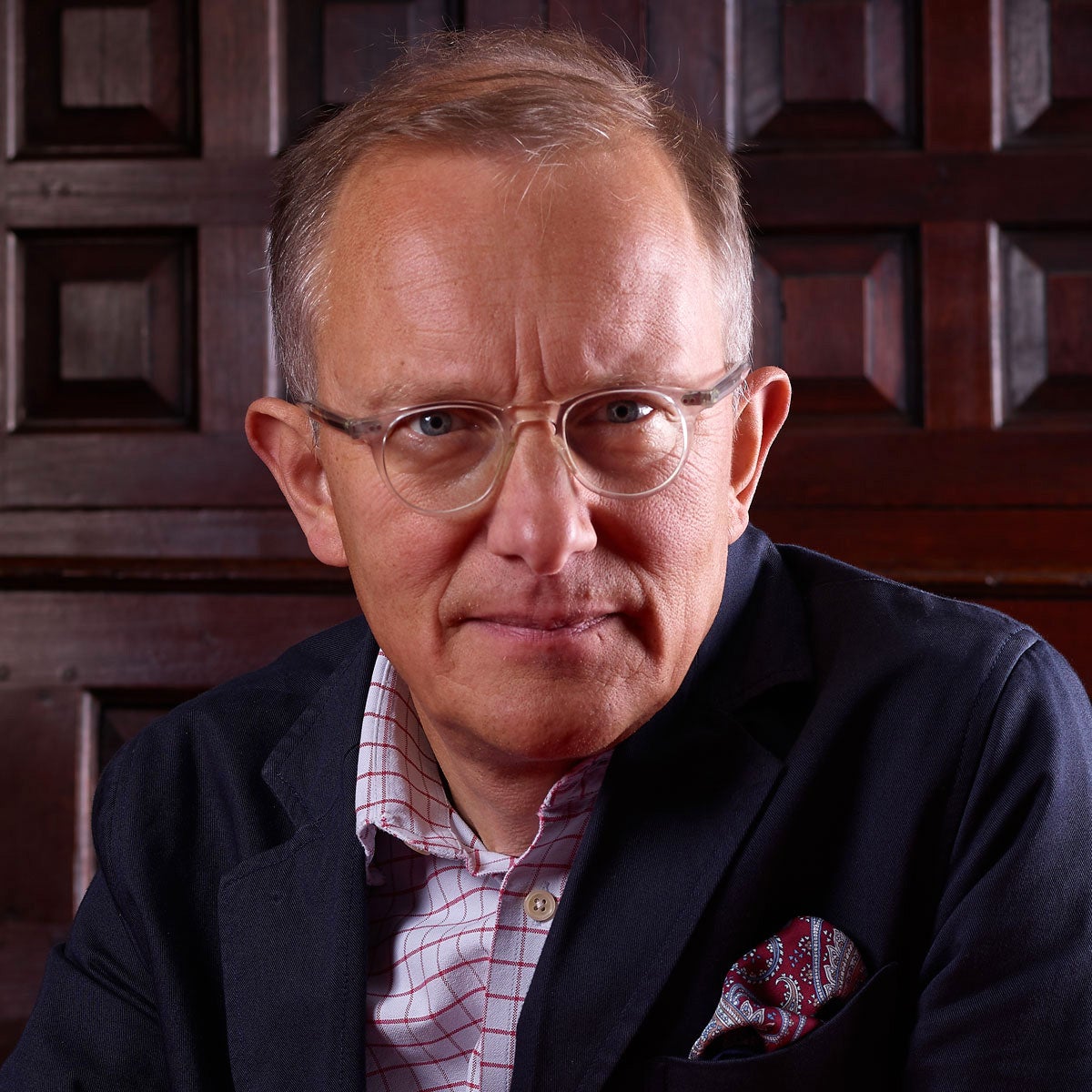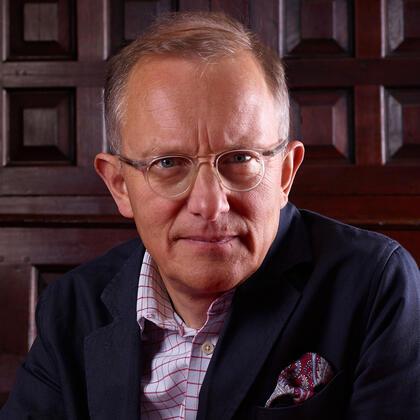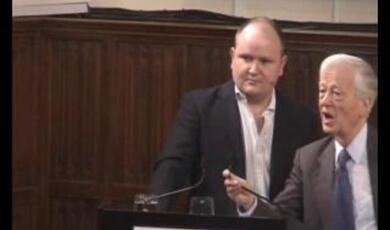Playing Catch-up: Palaces from the Hundred Years' War to the Wars of the Roses
Share
- Details
- Transcript
- Audio
- Downloads
- Extra Reading
What was the difference between the fortress of a great magnate and the palace of a king? A lack of differentiation dogged the medieval monarchy. Yet royal buildings were deliberately distinct from their aristocratic imitators.
Download Transcript
23 April 2014
Playing Catch-up:
Palaces from the Hundred Years' War
to the Wars of the Roses
Professor Simon Thurley
Last time I finished by showing you this plan of Windsor Castle. It shows the extraordinary suite of royal chambers constructed by King Edward III as they existed at his death in 1377. These works at Windsor were utterly and completely consuming and it is perhaps not surprising that during Edward III’s reign Windsor was very much the centre of royal gravity. But in the second year of Richard II’s reign came a reform that was to shift the focus away from Windsor to Westminster and was to establish a permanent office or department to organise royal building. The Office of the King’s Works was established in 1378 and was placed under a Clerk who in charge of the organising construction and maintenance and a Comptroller responsible for financing it. Although his headquarters was in Westminster the Clerk had extensive responsibilities across England and appointed regional assistants known as purveyors who recruited craftsman and organised the delivery of materials. The Clerk and the Comptroller received both fees and a livery, in other words the right to wear a special robe. Before the Reformation many Clerks of the King’s Works were in Holy Orders, but not all were. Most famously the poet Geoffrey Chaucer, a layman, served as Clerk from 1489 to 1491.
The Clerks were not architects or builders, they were administrators who handled very substantial sums of money, sometimes drawn from other royal departments, and usually moving on to more responsible posts in royal service. Their office was in the Palace of Westminster where the accounts office, drawing office and materials stores clustered together in the shadow of Westminster Hall.
Working closely with the Clerk and Comptroller were a number of official royal craftsmen - a Master Carpenter, Master Mason, Master Plumber plus a Glazier and a Blacksmith. It was these men who possessed the technical skills in design, engineering and construction that today we would call architectural. Master Craftsmen were responsible for taking a brief set by the king or his officials and translating it into drawings and sometimes a model. They were experts in geometry and had leant the principles of engineering from first-hand experience as apprentices and then junior practitioners. They worked as a team, the masons designing the walls, the carpenters the roofs, doors and panelling, the glaziers the stained glass windows, the smiths the ironwork and the plumbers the leadwork. Of course they conferred, but each had his craft or mystery and each reigned supreme over his own.
The master masons and carpenters were men of high ability and reputation and like the Clerk and Comptroller had the right to a livery and some status amongst the king’s servants and administrators. The master smith was mainly engaged in making weapons, but his forges at the Tower of London also furnished all the domestic needs of the king as well. He and his colleagues the plumber, glazier and later the master painter all were furnished with liveries and all had the status of squires in the king’s household.
It would be nice to imagine that the establishment of this the first official architectural and construction department was due to some desire to improve the quality of design and construction; but it wasn’t. This was a piece of bureaucratic engineering, a way of more efficiently managing the royal estate. We should note that not everything was included, in particular the houses that belonged to the queen were managed separately by her own household. As we shall see in later lectures this has given us a problem in properly visualising the houses of England’s queens.
The Office of the King’s Works was a body that continued to exist for the next four hundred years and became the most important body of building professionals in English architecture. We in England, unlike in France, had no royal architectural academy, nor before the late nineteenth century, any formal training for architects. As a result the Office of Works became the school in which almost all of the greatest names in English architecture trained. By extension this means that the construction and maintenance of the royal estate and, to a degree, the estate of the army and navy were the practical forcing grounds of English architectural and technological innovation.
So lets now move on the from bureaucratic bit to consider what was built by monarchs between Richard II and Richard III, ie in the years between Edward III death in 1377 and Richard III’s defeat at Bosworth field in 1485. Well, its rather a difficult period to characterise because although just under £64,000 was spent by the new Office of Works on the king’s houses during the period there were major building works at only two places.
In the period after Edward III’s death up until the accession of Henry VII monarchs bought and sold houses, swapped and confiscated them. Only seven residences remained in constant royal ownership and use: in London and the Thames valley, Westminster, the Tower of London and Windsor Castle; to the west Clarendon and Woodstock, Havering in Essex and in Nottinghamshire Clipstone. Many other royal houses were owned for brief periods (some for nearly a century) but the core of large royal residences was shrinking.
There were four reasons for this
1. From around 1370 Edward III becomes much more sedentary (and gradually senile) and more-or-less holes up at Windsor and Windsor Manor; he very rarely went to Westminster or the Tower. This increased the centralisation of government and administration in Westminster – from the end of Edward III’s reign the king’s council always met at Westminster and all the king’s household depts. have headquarters at Westminster.
2. Relative poverty of the fourteenth and fifteenth century monarchy in comparison with the wealth of the 12th and 13th century. This, in turn was at least partly due to a greater reliance on taxation rather than taking income from directly managed estates. So there was simply not so much money to spend on grandiose building projects.
3. Increasing expectations of comfort and convenience by the royal family. Monarchs and their families were no longer prepared to doss down in make-shift accommodation in ancient and rarely used castles or manors. They expected warm rooms, well-appointed with proper cooking and washing facilities. These could only be provided as a relatively small number of residences.
4. Lastly the royal household was getting bigger all the time. Henry I’s Household was around 150 retainers while Edward I had around 600 people in his household and Richard II’s was perhaps 700. The increasing size of the royal household led to a corresponding lack of mobility as moving so many people around was expensive and complicated. The larger household also meant that fewer royal houses could accommodate such numbers and the places in which the household could stay were reduced.
So over the whole of this period the trend was for fewer and larger houses nearer to London. This very much accorded with changes in the nature of the royal court
Now this is the first time I have used this term so explicitly. So we need to ask the question when do we see a court? Well, of course this rather depends on the definition of the word, but historians in the past have argued that the court was essentially an invention of the Tudors – Introduced by Henry VII and perfected by Henry VIII. We no longer really believe this and in fact I think the court as a recognisable concept to us today was born in the period that we are considering tonight.
Let’s be clear first of all about the difference between the household and the court. The household is straightforward to define; it was the structured organisation that sustained the life and therefore the rule of the monarch. It contained all the functions necessary for everyday life and for the normal business of ruling. The court, however, is a more amorphous concept for it had no static membership but contained those people who were at that time welcomed by the king as participants in his daily round of life. They might be his friends, they were certainly his supporters and they were part of the setting of kingship, ornaments to the king’s power. So there was a sense of spectacle to the court, while the household was the machinery that made that spectacle possible.
A crucial component of a court is courtliness, some refinement of manners and behaviour to which its members subscribe. It became possible for this to flourish when the king’s closest attendants ceased to be soldiers geared to military action. At that point it is possible to enjoy a greater interest in the arts; in tapestry, painting, poetry, sculpture and music. It also becomes possible to admit more women into the everyday mix of people surrounding the monarch.
Many of these things can be discerned, perhaps, as early as the reign of Henry III, but I think we are safe in arguing that all of them become a marked and remarked-upon feature in the reign of Richard II. Historians love to pinpoint when things start, well, I won’t disappoint you tonight, because I think that a royal court in a recognisable sense to us today begins to exist from the reign of Richard II. Here was a court which expressed an interest in culture, which comprised women to a much greater degree than previously, that could portray itself magnificently and that had a sense of hierarchy expressed in degrees of status and deference. Richard loved to wear his crown, presiding imperiously enthroned over banquets, religious feasts and audiences. He was preoccupied by ceremony and his court festivities became more formalised and ceremonious. He loved rich clothes, priceless personal jewellery, rich food and enjoyed having himself portrayed by painters.
This was a very different environment from that which surrounded King Edward I seventy years before. His was a business-like household, full of military men and administrators. Those who had the greatest status were his fifty household knights, the royal bodyguard, in effect, a sort of elite standing army. Their friendship and loyalty had been forged in blood and battle and they set the militaristic tone of the king’s entourage. Everyone below them from pages and grooms to cooks and tailors had a military role to play when the household was at war. Rubbing shoulders with the king’s knightly companions were his administrators, the men who facilitated Edward’s rule principally through a household department called the Wardrobe – then the chief spending department of the state. The camaraderie and bonhomie of the soldier brought an informality of tone in which the king and his subjects mixed freely during everyday exchanges and even on special occasions.
Richard II’s household was not alone in adopting this less militaristic and more ceremonious character. Royal households across Europe were becoming more formalised partly, perhaps, in reaction to waves of violent unrest across Europe. The most notable English expression of this was the Peasants Revolt of 1381. Richard’s upbringing and character were important too as was his interest in the court of France, and later his sense of rivalry with it.
There were significant architectural implications in this shift from a household to a court. The foundations of this were laid in the reign of Edward III. Windsor Castle, as we saw last time, was an extraordinary building; entirely new in its architectural ambition, in its sophistication of planning and in the way the great rooms of state conveyed the leisured magnificence of the monarch.
Crucially Edward’s conception for Windsor was not just the great castle it was for a conglomeration of residences. Windsor was the hub but around it were a ring of smaller houses: Easthampstead, Foliejohn, Henley on the Heath, Wychmere and Windsor Manor (in the Great park). Each of these had their own fenced hunting grounds. In the latter years of Edward’s life one of these, Windsor Manor, was his private retreat and it was here that the king stayed rather than at the big castle. Edward II and III established the principle that their most favoured houses were put under the control of the Chamber – a personal area of control and finance. By putting these houses under the direct control of his personal servants they ensured that they were not invaded by constables, clerks of works etc who were not part of his inner entourage. This was a way of making the distinction familiar to us today between the personal and official estate of the crown. The difference between the queen’s private property at Balmoral and her official residence at Buckingham Palace, for instance.
We will see in a few moments how the use of chamber finance could signify the personal importance of a building project for a monarch. But having said that we have two problems tonight: the first is that, apart from Richard II, few of the monarchs who we will consider were, in fact, builders at all. Henry IV had acute financial problems, Henry V spent much of his reign abroad and Henry VI who commissioned much little was achieved, under Edward IV something was built. So this evening I’m really going to concentrate on the two major royal domestic commissions of the period at Westminster and at Sheen.
Henry III had made Westminster Hall into the principal throne room of the land with a permanent marble throne set on the dais behind a massive marble table. Near this met the courts of King’s Bench, Chancery and Common Pleas, in the presence, as it were, of the king. In 1393 Richard II decided to rebuild Westminster Hall, a project that was completed by 1401. The massive Norman walls were retained and Richard’s masons inserted big new gothic windows in them. Beneath was a cornice richly carved with Richard’s heraldic beasts. The Norman roof was replaced with the largest and most important piece of carpentry in Western Europe. The challenge for Hugh Herland, Richard II’s Master Carpenter was how to span the incredible width of the hall. To do this he used an emerging structural technique that was being successfully employed at Dartington Hall, Devon: the hammer beam roof. This type of roof shortens the span that has to be covered by cutting the tie beam and leaving its stubs as projecting timbers or hammer beams. These are supported by curved braces from the wall. The hammer beams then reduce the span for the principal arches.
On each hammer beam was a massive angel holding the arms of England, the roof was thus a representation of the heavens spread over the earthly court of Richard II. This was not the only religious connotation of the hall for on the south wall, behind the dais, were six rich niches containing figures of kings rather like a cathedral pulpitum, as at York Minster, for instance. The entrance façade was also treated like a cathedral or great abbey with two towers clad with a screen of twenty-seven niches containing statues of kings and queens. This was more like the west front of a cathedral than a secular great hall. In addition most great halls were entered from the long side, not the short end. The great screen at Westminster made visitors feel as if they were entering a great religious building not the secular hall of a monarch. You see in terms of architectural hierarchy Westminster Hall, uniquely in English medieval architecture, sought equivalence of status with the most important religious buildings, a comment on Richard II’s conception of kingship.
So this incredibly important commission illustrates perfectly what I have been saying about the nature of Richard II’s rule and his elevation of his kingly office above the leader of a war band. Westminster Hall stated unequivocally Richard’s intention to create a monarchy and a court which was of a scale of magnificence never seen before. But we can also see at his works at Sheen how it was not only just the public-facing monuments that conveyed this message. The king’s own favoured private residences were of a level of comfort and sophistication not yet seen.
Richmondupon Thames had been called Sheen since at least Anglo-Saxon times. It only became known as Richmond in 1501 in circumstances that we will come to in my next lecture. The manor of Sheen came into royal possession in 1313. At this date the crown owned vast tracts of Britain and the royal ownership of a manor did not necessarily mean that the king or his family would have a house there or even stay there. But King Edward III (1327-77) decided that he would build a house at Sheen and he and his successor, Richard II, spent a great deal of time here until in June 1394 his wife Queen Anne died in the house.
However we do know a bit about Edward’s and Richard’s Sheen from their building accounts. The place was entered over a bridge and through a great gate. There was a hall and a chapel and various (un-named) chambers for the king and queen and lots of lodgings for their household. There were also the normal service buildings including kitchens and stables. Edward III spent a lot of time there in his old age and in fact died there in 1377. Richard made some additions which accord with the luxury-loving prince that I have already characterised.
First he built a luxurious little retreat on an island in the Thames; it had several rooms all heated by fireplaces and its own kitchen – a new barge and landing stage were made to enable the king to get there in comfort and style. In the main manor the king had a new bathroom for which tiles were ordered. These glimpses perhaps help explain what happened next. For Sheen must have been an intimate retreat beloved by the king and queen for on Queen Anne’s death Richard, in a fit of grief ordered the whole place to be knocked down and the site levelled.
It is a shame that we cannot visualise either the manor or Richard’s island retreat called La Nayght. But a visit to Kenilworth Castle can give you some idea of what, perhaps it might have been like, because there in 1417 Henry V began the construction of a very similar private hideaway reached only by barge across the water. This was probably larger than La Nayght, but a visit to the site today you can still make out the foundations of the fifteenth century buildings.
The first royal palace at Sheen was an important country house for the royal family but never the most important country house. Henry V, however decided to build a place that would be regarded as the Lancastrian dynastic seat. You see Kings of England have, throughout the ages settled on particular country palaces to be the principal symbols of their rule while Westminster remained their permanent official seat. Edward III, as we have seen, chose Windsor Castle, which he massively enlarged. In later times, for instance, Henry VIII decided to build Nonsuch in Cheam as a monument to his rule. It was begun on the thirtieth anniversary of his accession and was designed to be a lasting symbol of Tudor government. Neither of these monarchs intended these houses to be their only seat but each of them wanted to have a special country seat, one that they took a particular interest in, that would be especially associated with them or their dynasty.
The second palace built at Sheen, near to the site of the palace demolished by Richard II, was just such a residence. It was begun by Henry V in 1414 and continued to be constructed by him until his death in 1422. After that his son Henry VI finished the works. Between them they built the greatest monument to Lancastrian rule, a great stone-built riverside residence proclaiming the solidity and permanence of the Lancastrian dynasty. We have no contemporary paintings or drawings of this house but we know what it must have looked like as its principal feature, a great stone-built block of lodgings on the riverside, survived into the seventeenth century. Here is a painting in the Society of Antiquaries in London. We don’t know who it is by but it was done around 1640. What it shows is the stone lodging block on the river. This was essentially a medieval keep or donjon, and like other donjons it contained the principal rooms of the house. Ignore for the moment the onion domes on the turrets and the brick chimneys these were built by Henry VII and we will hear about them next time.
Other later views give an impression of what this house must have been like. Recent archaeological work and the discovery of a plan of the block have enabled an accurate plot of the great stone donjon to be made. From this we can see that it was perhaps rather like the great tower at Warkwarth Castle in Northumberland built in the 1380s, that is to say started around 30 years before Sheen. You can see how it is apparently very irregular from the outside and inside it had an amazingly ingenious plan. This was a luxurious retreat perhaps very similar in its complexity of layout to Warkworth. The man in charge of the design of this enterprise was the king’s master mason Stephen Lote. Sheen was his masterpiece; when he died in 1418 he left in his room at Sheen all the drawings of the palace and bequeathed them to his fellow mason Thomas Mapulton. This does suggest that he lived on site and personally oversaw the work.
The level of personal interest shown by henry V is perhaps indicated by something else. Between 1414 and 1419 the king spent £8,000 on house and £2,000 on two religious houses next door, but £7,363 of the work was funded from the king’s personal fund the chamber rather than the exchequer. As I explained earlier this gave the king’s own household much greater influence over the outcome than if it had been paid through the exchequer.
So while the period that we have been looking at this evening is not notable for a large number of important buildings, it is important for some fundamental changes that took place in the nature of the royal household. Primarily we can see the development of what we would recognise as a court and with it an elevation of the person of the king above his fellows. In this we see an architectural aggrandisement of royal buildings as seen at Westminster hall and a greater concentration of the personal and private luxury of the monarch as at Sheen and Kenilworth.
Not far from here is Eltham. This was a palace that was enjoyed by both Edward III and Richard II, although not much of their work survives. What does survive is the single most important remaining architectural work of the Lancastrian kings. The great hall. This was built by Edward IV in the 1460s. here you begin to see the fusion of monumental public magnificence with an increasing emphasis on the private and personal space occupied by the king. This is the great theme that was developed under the two Henry’s, the subject of my talk on the 4th June.
© Professor Simon Thurley, 2014
Part of:
This event was on Wed, 23 Apr 2014
Support Gresham
Gresham College has offered an outstanding education to the public free of charge for over 400 years. Today, Gresham plays an important role in fostering a love of learning and a greater understanding of ourselves and the world around us. Your donation will help to widen our reach and to broaden our audience, allowing more people to benefit from a high-quality education from some of the brightest minds.


 Login
Login







